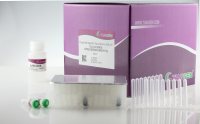Making Sense of DNA Microarray Data
互联网
524
The fast advance of genomic science and nucleic acid detection technology provides medical researchers new tools for detecting genetic and expressional variations of individuals and their relations to pathology, etiology, and diagnostics. DNA microarrays, also called DNA chips, contain many different single-stranded DNA segments immobilized on specified locations of glass or other solid surfaces (1 ,2 ). In a DNA microarray experiment, the free DNA or RNA segments in solution hybridize with the immobilized DNA segments with known sequences at known locations owing to base pairing. The immobilized DNA segments are called the probes, and the nucleic acids whose identity or abundance are to be detected are called the targets. Because targets are usually labeled with fluorescent tags, the hybridized targets can be readily detected with laser scanners or charge-coupled device cameras. The locations and intensities of the fluorescent signals on a microarray reveal the sequence and/or abundance of specific targets.






